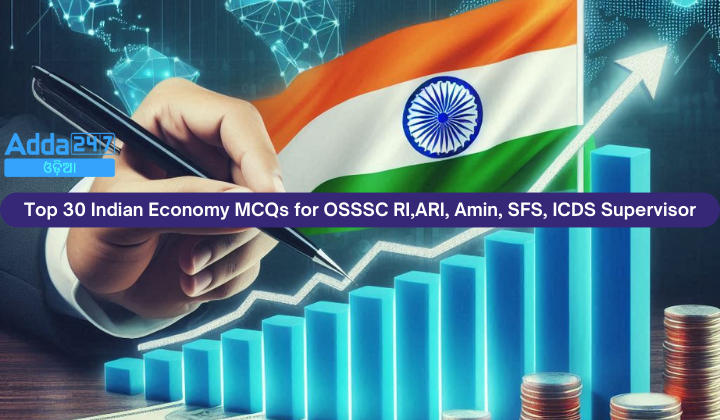Preparing for the OSSSC RI, ARI, Amin, SFS, and ICDS Supervisor exams requires a solid understanding of the Indian economy. These competitive exams often feature questions on economic concepts, policies, and current trends. A focused study of the top 30 multiple-choice questions (MCQs) can significantly enhance your readiness. These questions cover critical topics such as GDP growth, inflation, fiscal policy, banking reforms, and trade. They are tailored to align with the exam pattern, helping candidates gain a comprehensive overview and practice efficiently for their upcoming assessments.
Top 30 Indian Economy MCQs for OSSSC RI,ARI, Amin, SFS, ICDS Supervisor
- Which act regulates MSMEs in India?
(a) Companies Act, 2013
(b) Micro, Small & Medium Enterprises Development (MSMED) Act, 2006
(c) Industrial Disputes Act, 1947
(d) Factories Act, 1948
Answer: (b) Micro, Small & Medium Enterprises Development (MSMED) Act, 2006 - Which body manages MSMEs in India?
(a) Ministry of Commerce and Industry
(b) Ministry of Finance
(c) Ministry of MSME
(d) Ministry of Labour and Employment
Answer: (c) Ministry of MSME - As of July 2020, how are MSMEs classified?
(a) Only by investment in plant and machinery
(b) By investment in plant and machinery and annual turnover
(c) Only by annual turnover
(d) By number of employees and annual turnover
Answer: (b) By investment in plant and machinery and annual turnover - What is the investment limit for a Micro Enterprise under the new classification?
(a) INR 1 crore
(b) INR 5 crore
(c) INR 10 crore
(d) INR 50 crore
Answer: (a) INR 1 crore - Which statutory body under the Ministry of MSME promotes khadi and village industries?
(a) Coir Board
(b) National Small Industries Corporation Limited (NSIC)
(c) Khadi and Village Industries Commission (KVIC)
(d) National Institute for Micro, Small and Medium Enterprises (NI-MSME)
Answer: (c) Khadi and Village Industries Commission (KVIC) - What is one of the primary functions of the Coir Board?
(a) Promoting khadi products
(b) Enhancing rural employment
(c) Improving the living conditions of coir workers
(d) Conducting policy-formulating studies
Answer: (c) Improving the living conditions of coir workers - Which institution focuses on promoting entrepreneurship and conducting policy-formulating studies?
(a) Mahatma Gandhi Institute for Rural Industrialisation (MGIRI)
(b) Khadi and Village Industries Commission (KVIC)
(c) National Small Industries Corporation Limited (NSIC)
(d) National Institute for Micro, Small and Medium Enterprises (NI-MSME)
Answer: (d) National Institute for Micro, Small and Medium Enterprises (NI-MSME) - What is the employment contribution of MSMEs to India’s manufacturing output?
(a) 20%
(b) 25.4%
(c) 30.4%
(d) 35.4%
Answer: (d) 35.4% - Which of the following is a significant challenge faced by MSMEs in India?
(a) Excessive training programs
(b) Easy access to credit
(c) Heavy licensing, inspection, and compliance requirements
(d) Adequate data collection
Answer: (c) Heavy licensing, inspection, and compliance requirements - What is one recommendation to support the growth of MSMEs in India?
(a) Increase compliance burden
(b) Reduce space regulations
(c) Enhance training programs for entrepreneurs
(d) Decrease financial schemes
Answer: (c) Enhance training programs for entrepreneurs - What is the primary purpose of the Minimum Support Price (MSP)?
a) To increase agricultural exports
b) To provide farmers with a minimum guaranteed price for their produce
c) To encourage farmers to switch to organic farming
d) To reduce the use of chemical fertilizers
Answer: b) To provide farmers with a minimum guaranteed price for their produce - Which government body is responsible for recommending the MSP?
a) Food Corporation of India (FCI)
b) Commission for Agricultural Costs and Prices (CACP)
c) Reserve Bank of India (RBI)
d) National Bank for Agriculture and Rural Development (NABARD)
Answer: b) Commission for Agricultural Costs and Prices (CACP) - How often is the MSP for different crops announced?
a) Monthly
b) Annually
c) Biannually
d) Quarterly
Answer: c) Biannually - The MSP is set at least one-and-a-half times which of the following costs?
a) Market price
b) Export price
c) Cost of production
d) Retail price
Answer: c) Cost of production - For how many crops does the Indian government announce the MSP?
a) 12
b) 18
c) 22
d) 24
Answer: c) 22 - Which crops are primarily procured by the government under MSP?
a) Pulses and oilseeds
b) Rice and wheat
c) Fruits and vegetables
d) Cotton and jute
Answer: b) Rice and wheat - What is the role of the Food Corporation of India (FCI) in the MSP system?
a) Setting the MSP
b) Recommending the MSP
c) Procuring crops at MSP
d) Providing loans to farmers
Answer: c) Procuring crops at MSP - Which committee recommended at least a 50% profit margin above the cost of production in MSP?
a) Shanta Kumar Committee
b) Swaminathan Commission
c) Agricultural Prices Commission
d) National Commission on Farmers
Answer: b) Swaminathan Commission - What is one of the major issues associated with the MSP system?
a) Overproduction of pulses
b) Ineffective implementation
c) High export prices
d) Low production costs
Answer: b) Ineffective implementation - Which of the following is NOT a feature of the MSP system?
a) Pre-announced price
b) Safety net for farmers
c) Unregulated market prices
d) Government intervention
Answer: c) Unregulated market prices - What was the employment figure in India for FY24 according to RBI’s data?
(a) 57.75 crore
(b) 59.67 crore
(c) 64.33 crore
(d) 56.56 crore
Answer: (c) 64.33 crore - How much did the employment increase in FY24 compared to FY23?
(a) 3.58 crore
(b) 4.67 crore
(c) 5.58 crore
(d) 2.75 crore
Answer: (b) 4.67 crore - What was the recorded employment in FY22?
(a) 57.75 crore
(b) 56.56 crore
(c) 64.33 crore
(d) 59.67 crore
Answer: (b) 56.56 crore - What was the unemployment rate in urban areas for individuals aged 15 years and above in the January-March quarter of 2024?
(a) 6.8%
(b) 7.5%
(c) 6.7%
(d) 5.9%
Answer: (c) 6.7% - The female unemployment rate dropped from 9.2% in January-March 2023 to what percentage in January-March 2024?
(a) 8.5%
(b) 7.9%
(c) 9.1%
(d) 8.7%
Answer: (a) 8.5% - The Labour Force Participation Rate (LFPR) in urban areas for those aged 15 years and above increased to what percentage in January-March 2024?
(a) 48.5%
(b) 47.2%
(c) 50.2%
(d) 49.5%
Answer: (c) 50.2% - What was the Worker Population Ratio (WPR) for individuals aged 15 years and above in January-March 2024?
(a) 44.5%
(b) 46.9%
(c) 45.2%
(d) 47.1%
Answer: (b) 46.9% - By how much did the female Worker Population Ratio in urban areas increase from January-March 2023 to January-March 2024?
(a) 2.8%
(b) 1.9%
(c) 2.5%
(d) 2.0%
Answer: (a) 2.8% - What was the female unemployment rate in June 2024?
(a) 15.1%
(b) 18.5%
(c) 19.3%
(d) 16.7%
Answer: (b) 18.5% - According to the Centre for Monitoring Indian Economy (CMIE), what was India’s unemployment rate in December 2022?
(a) 7.44%
(b) 9.3%
(c) 10.09%
(d) 8.30%
Answer: (d) 8.30%
















